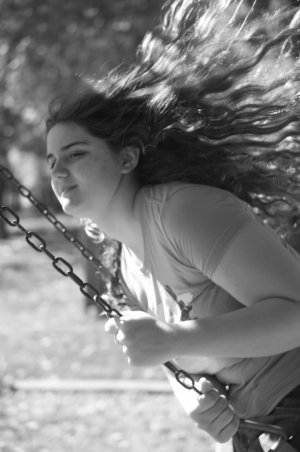Loovic07
Newbie
Since my return to film photography about 18 months ago, I hear the term "vintage look" relentlessly when referring to old glass.
What does this mean to you – perhaps just blurry low contrast flare ridden images ?
And why do you like the look (if it exists) so much?
What does this mean to you – perhaps just blurry low contrast flare ridden images ?
And why do you like the look (if it exists) so much?
"Vintage Look" seems to be the opposite of "Sterile Look".
I tend to use "Classic Design".
Digital sensors require that light fall much more directly on the sensor, requiring changes to optimize a lens. This is similar to changes in lens design for SLRs for shorter focal lengths. Wide-angle lenses are retro-focus design, to clear the mirror. Side-Effect, light falls directly on a digital sensor. Expand the concept to change the optical design of lenses for Digital cameras to a long/drawn-out optical path, and use all the extra elements to eliminate aberrations.
Rangefinder film cameras allow use of classic lenses. Leica digital cameras have special sensors designed for classic lenses, optimized for accepting light coming in at sharp angles. SO- if you want the "vintage Look", no camera better to use the lenses than your Canon P.
 rangefinderforum.com
rangefinderforum.com
This is with my 1936 Carl Zeiss Jena Sonnar 5cm F1.5, one of the first lenses with coated optics. From the test batch.
The Sonnar design is "Asymmetric", rear element sits close to the image plane. Light comes in at steep angles to the sensor. This is on the Leica M9, CCD sensor optimized for lenses like this.
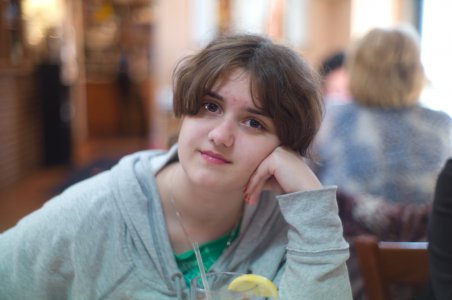
On film, Canon 50mm F1.5 at F2. This is Canon's Sonnar formula lens.
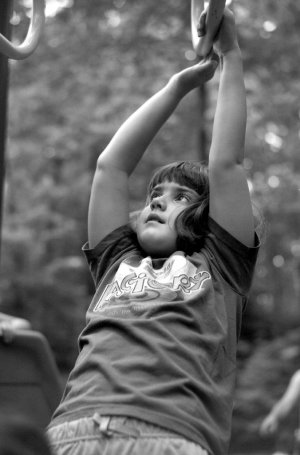
Center Sharp, low astigmatism, high Coma, high field curvature. Higher contrast as there are less optical surfaces.
I tend to use "Classic Design".
Digital sensors require that light fall much more directly on the sensor, requiring changes to optimize a lens. This is similar to changes in lens design for SLRs for shorter focal lengths. Wide-angle lenses are retro-focus design, to clear the mirror. Side-Effect, light falls directly on a digital sensor. Expand the concept to change the optical design of lenses for Digital cameras to a long/drawn-out optical path, and use all the extra elements to eliminate aberrations.
Rangefinder film cameras allow use of classic lenses. Leica digital cameras have special sensors designed for classic lenses, optimized for accepting light coming in at sharp angles. SO- if you want the "vintage Look", no camera better to use the lenses than your Canon P.
Ninety Years of Sonnars- From the Carl Zeiss Jena 5cm F2 to the The 5cm F2 Bertele Sonnar
Interchangeable lens 35mm rangefinder cameras made their debut over 90 years ago when Leitz introduced the Leica II and Zeiss debuted the Contax I. The first lenses for these cameras were Tessar formula lenses of modest speed. The 5cm F3.5 Tessar was produced in Contax RF mount in 1931, and was...
 rangefinderforum.com
rangefinderforum.com
This is with my 1936 Carl Zeiss Jena Sonnar 5cm F1.5, one of the first lenses with coated optics. From the test batch.
The Sonnar design is "Asymmetric", rear element sits close to the image plane. Light comes in at steep angles to the sensor. This is on the Leica M9, CCD sensor optimized for lenses like this.

On film, Canon 50mm F1.5 at F2. This is Canon's Sonnar formula lens.

Center Sharp, low astigmatism, high Coma, high field curvature. Higher contrast as there are less optical surfaces.
Last edited:
Erik van Straten
Mentor
"Vintage look" is for me not only the lenses used, but should also be photography on film. I like it when the picture frame of the camera is included in the picture. This effect cannot be achieved with a digital camera, at most it can be imitated, creating a kitsch effect.
gelatin silver print (summar 50mm f2) leica lll
Amsterdam, 2022
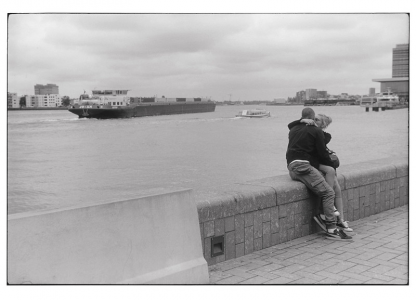
gelatin silver print (summar 50mm f2) leica lll
Amsterdam, 2022

AAlfano
Well-known
Vintage look:
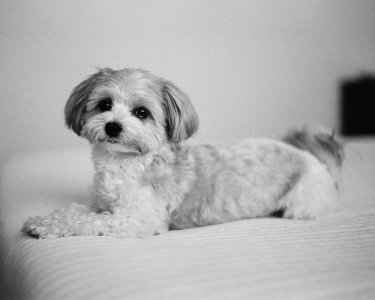
I shot this on Tri-X with my Pentax SL and 50mm f/1.4 S-M-C Takumar lens. Developed and scanned by Fulltone photo. The only thing I did to the scan was crop it to 4:5.
"Modern look":
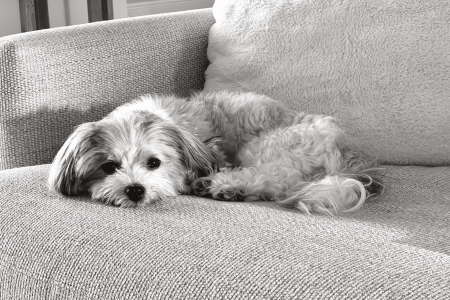
Shot on iPhone 13 Pro with the telephoto camera, edited in Photos app, and "developed" into black-and-white in Darkr.
I think the "blurry, low contrast, flare ridden" "vintage look" is mostly a marketing gimmick. A lot of people's last recollection of film comes from the crappy disposable cameras and 35mm point-and-shoots of the 90s, so that's what they think film photos are supposed to look like.

I shot this on Tri-X with my Pentax SL and 50mm f/1.4 S-M-C Takumar lens. Developed and scanned by Fulltone photo. The only thing I did to the scan was crop it to 4:5.
"Modern look":

Shot on iPhone 13 Pro with the telephoto camera, edited in Photos app, and "developed" into black-and-white in Darkr.
I think the "blurry, low contrast, flare ridden" "vintage look" is mostly a marketing gimmick. A lot of people's last recollection of film comes from the crappy disposable cameras and 35mm point-and-shoots of the 90s, so that's what they think film photos are supposed to look like.
Digital Frames... You can get them, but need to write your own software for it..."Vintage look" is for me not only the lenses used, but should also be photography on film. I like it when the picture frame of the camera is included in the picture. This effect cannot be achieved with a digital camera, at most it can be imitated, creating a kitsch effect.
gelatin silver print (summar 50mm f2) leica lll
Amsterdam, 2022
View attachment 4834388
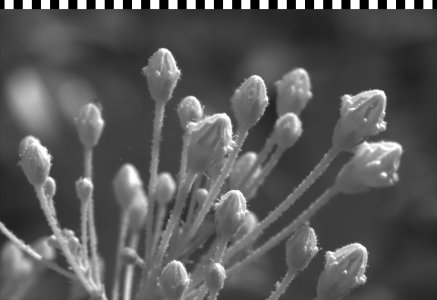
Kodak DCS200ir. Not sprocket holes, calibration pixels. "I Think", it is a Kodak. Maybe the engineers added sprocket holes on the CCD just to make them think of film.
Nikkor 55/2.8, R60 filter.
Timmyjoe
Mentor
I think AAlfano illustrates well what I mean when talking about "Vintage look". It's a bit softer, more organic, shallower depth of field, as opposed to what I call the "Clinical look" like the second image he posted. Because of the small sensors on phone cameras, and the improvement in lens quality on said phones, we're seeing a lot of tack sharp, huge depth of field images these days, which fall into the "Clinical look" in my opinion. I prefer the "Vintage look" myself.
Quick aside, I find the "Vintage look" to be much better at communicating an emotion, and the "Clinical look" much better at communicating information.
Best,
-Tim
Quick aside, I find the "Vintage look" to be much better at communicating an emotion, and the "Clinical look" much better at communicating information.
Best,
-Tim
AAlfano
Well-known
For me the dead giveaway of modern/digital images is the abrupt loss of highlights. For example, see the loss of detail in the white fur on the back of my dog's neck and shoulders, above, compared to the white fur on her muzzle.
AAlfano
Well-known
@Sonnar Brian OK, you got me. I saw the blown highlights on your daughter's right hand, and I would have thought it was a digital image.
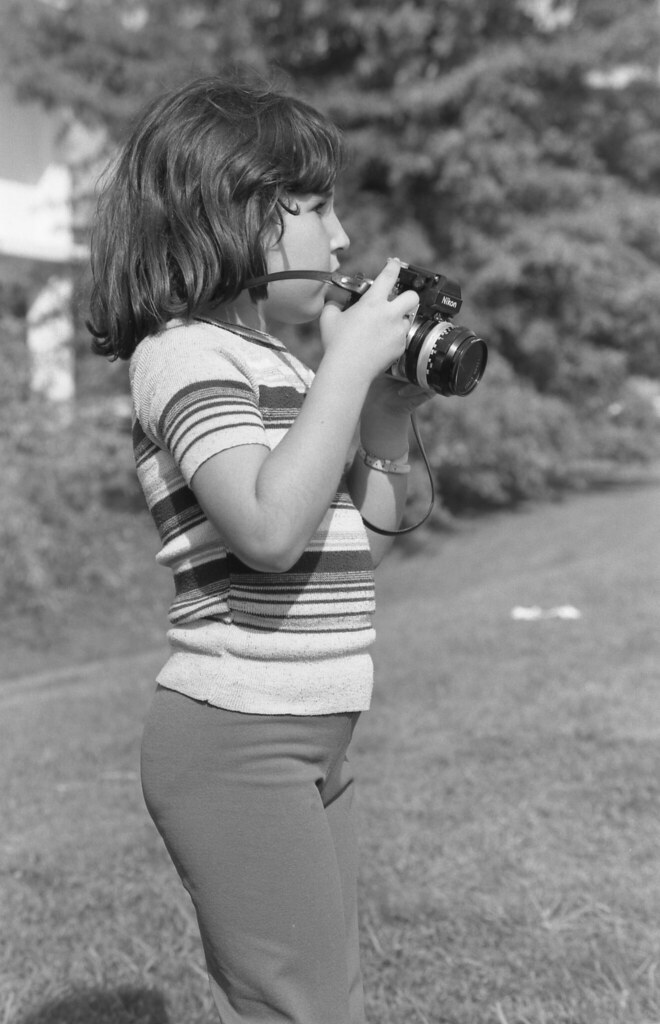 zoe1 by fiftyonepointsix, on Flickr
zoe1 by fiftyonepointsix, on Flickr Gamma 1.0 M1 DNG-16, Panatomic-X Emulation by fiftyonepointsix, on Flickr
Gamma 1.0 M1 DNG-16, Panatomic-X Emulation by fiftyonepointsix, on FlickrI associate "Vintage Look" more with lens design than "Film vs Digital". 60 years shooting film and 43 years "shooting" digital. "Way back When" used Film in the Lab, "Radiometrically Calibrated"- so learned a lot about film response.
The Digital image is made with a lens over 30 years older than the one I used in in the 1970s.
Just to add- I found the 8x10 polycontrast print of the girl with the F2a, for my University yearbook. What can I say- "High Contrast was in, Baby! Blown highlights and all" The 8x10 and negatives were in the same folder as a brochure for the "AED512 Color Graphics and Imaging Terminal".
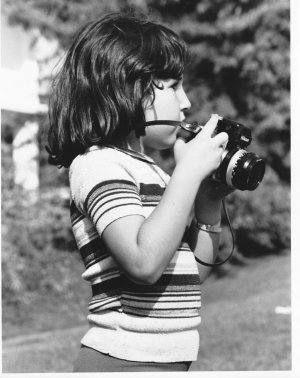
Vintage Digital.
Last edited:
Ko.Fe.
Lenses 35/21 Gears 46/20
From what I have seen for been pushed as "vintage look" it is rendering with defects generated by optics. Something soft, low contrast.
Which is nothing but special effects.
From my own experience with film photography as photogaphy, I was printing on papers from seventies. Not because I wanted something special looking, but because Ilford/Kentmere dr papers became insane expensive. People who are not into gear and photography often asked me how long time ago picture was taken. It was due to real darkroom print look. Single grade, fiber, heavy papers.
As for sterile remark. Not as simple. Plenty of vintage lenses gives sterile look if used for film (the original intention use).
Rigid Summicron I had was totally sterile on BW film. And not so much of the vintage on digital M. Just sharp and nice colors.
My best bw film lens is Summarit-M 35 2.5. It gives very vibrant bw film dr prints. Superior to sterile, flat and missing micro-contrast Color Skopar 35 2.5, for example. And it is awesome lens on digital M.
Or I liked how darkroom prints came out from sado-maso version of Nokton VM 50 1.5 ASPH. Again, nothing flat, plenty of microcontrast, which gives so called 3D. In the opposite Summicron 50 typ 4 was just awful. No character, totally sterile and flat lens on bw prints.
Which is nothing but special effects.
From my own experience with film photography as photogaphy, I was printing on papers from seventies. Not because I wanted something special looking, but because Ilford/Kentmere dr papers became insane expensive. People who are not into gear and photography often asked me how long time ago picture was taken. It was due to real darkroom print look. Single grade, fiber, heavy papers.
As for sterile remark. Not as simple. Plenty of vintage lenses gives sterile look if used for film (the original intention use).
Rigid Summicron I had was totally sterile on BW film. And not so much of the vintage on digital M. Just sharp and nice colors.
My best bw film lens is Summarit-M 35 2.5. It gives very vibrant bw film dr prints. Superior to sterile, flat and missing micro-contrast Color Skopar 35 2.5, for example. And it is awesome lens on digital M.
Or I liked how darkroom prints came out from sado-maso version of Nokton VM 50 1.5 ASPH. Again, nothing flat, plenty of microcontrast, which gives so called 3D. In the opposite Summicron 50 typ 4 was just awful. No character, totally sterile and flat lens on bw prints.
neal3k
Well-known
Here is my definition. Leica Summar 50mm f/2 from 1937.
 Tugboat by Neal Wellons, on Flickr
Tugboat by Neal Wellons, on Flickr
 The Way it Was by Neal Wellons, on Flickr
The Way it Was by Neal Wellons, on Flickr
 Night Rainbow by Neal Wellons, on Flickr
Night Rainbow by Neal Wellons, on Flickr
 Tugboat by Neal Wellons, on Flickr
Tugboat by Neal Wellons, on Flickr The Way it Was by Neal Wellons, on Flickr
The Way it Was by Neal Wellons, on Flickr Night Rainbow by Neal Wellons, on Flickr
Night Rainbow by Neal Wellons, on FlickrDogman
Mentor
Software can get you into the ballpark of "Vintage". Software and an old lens can get you onto the pitcher's mound. Using an older digital camera with lower resolution for the icing should be a home run. But digital is still digital and it retains a cleaner look to my eyes even when it's been dirtied up with software. I don't mind this at all. I learned photography and practiced it for decades mainly with Tri-X film and I still love the look. But I'll just take old cameras and lenses and Silver Efex software and play with my images in Lightroom and get something I like and consider it a victory for vintage look as of Century 21.
Here's an old lens (Nikkor 105/2.5) used on a low resolution full frame camera (Nikon D3) and processed in Silver Efex and Lightroom. It's a little soft, a little false grain has been added, etc. Should get the full "Vintage" look. But it still looks digital to me. Again, I don't mind that.
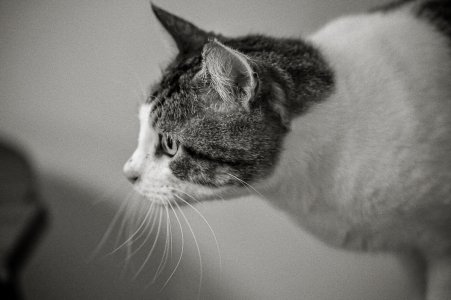
........................
Here's an old lens (Nikkor 105/2.5) used on a low resolution full frame camera (Nikon D3) and processed in Silver Efex and Lightroom. It's a little soft, a little false grain has been added, etc. Should get the full "Vintage" look. But it still looks digital to me. Again, I don't mind that.

........................
Ororaro
Well-known
Well, Elvis the movie, the final scenes at the airport, the black limo, priscilla saying farewell… wow. I had to watch those 2’minutes at least 10 times.
Just beautiful.
Also, the latest winogrand color book. There is one particular lens that strikes me. I will post about it in a new post. Just wonderful.
Just beautiful.
Also, the latest winogrand color book. There is one particular lens that strikes me. I will post about it in a new post. Just wonderful.
S.H.
Picture taker
Well, everyone has his definition of the "vintage look". Some think it is low resolution, low contrast, blurry, etc... Of course, sharp contrasty high rez pictures were made more than 100 years ago already...
I only use film these days, and older optics. Can't afford new top of the line gear and not sure I would even like it. After playing with gear for almost 2 decades I think it is the feeling of a paper picture in your hand that really defines the "vintage look" for me : not a pixel in sight. Grain instead of regular noise. When zooming in the image gradually fades into grain instead of hitting its native resolution wall and exploding into squares. And also because I mostly use outdated high end gear, sharpness is there but not too much microcontrast, and smooth transitions between sharp in focus areas and blurry OOF background (modern optics on digital can have harsh transitions, with high contrast overall; not always pleasing).
I only use film these days, and older optics. Can't afford new top of the line gear and not sure I would even like it. After playing with gear for almost 2 decades I think it is the feeling of a paper picture in your hand that really defines the "vintage look" for me : not a pixel in sight. Grain instead of regular noise. When zooming in the image gradually fades into grain instead of hitting its native resolution wall and exploding into squares. And also because I mostly use outdated high end gear, sharpness is there but not too much microcontrast, and smooth transitions between sharp in focus areas and blurry OOF background (modern optics on digital can have harsh transitions, with high contrast overall; not always pleasing).
Mackinaw
Think Different
Many seem to consider the "vintage look" to be a bit soft, and lacking in contrast. But some pics taken back in the old days were just the opposite. My dad took this pic of my brother back in 1958 with his Argus C3 (the brick) on Kodachrome film. To me, it's sharp and contrasty, and looks like it was taken yesterday.
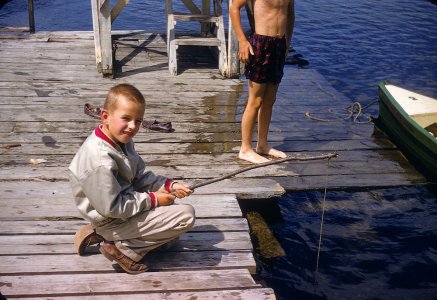
Jim B..

Jim B..
santino
FSU gear head
Many seem to consider the "vintage look" to be a bit soft, and lacking in contrast. But some pics taken back in the old days were just the opposite. My dad took this pic of my brother back in 1958 with his Argus C3 (the brick) on Kodachrome film. To me, it's sharp and contrasty, and looks like it was taken yesterday.
View attachment 4834447
Jim B..
It is Kodachrome, the best film ever 😉
Erik van Straten
Mentor
In my eyes this picture has the "vintage look". Shot with a black Leica lll from 1934 and a nickel Summar of the same vintage (but coated after the war) on Tmax400 film, developed in Ilford Perceptol and split-grade full frame printed on 17,8 x 24cm Ilford Multigrade FB glossy with a Leitz Focomat llc, a Focotar f=6cm 1:4,5 enlarging lens and a Hauck MSA II timer. The print was dried on a professional Büscher drying press.
Amsterdam, 2020
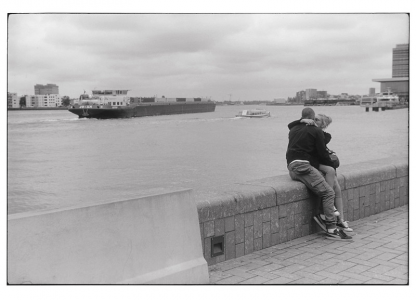
Amsterdam, 2020

Last edited:
Looking in the mirror, decades to achieve...
I have the Vintage Look. Vintage lens.... Any that are older than I am.
But.... the 1934 CZJ Sonnar 5cm F1.5 is my favorite. This is the "second formulation" of the F1.5 Sonnar, this is one of the later ones of that type.
Lots of deviation from sample-to-sample after 90 years, a matter of the "Bloom" of the uncoated glass, and how they were treated. This one was like wax paper when bought for $70 off Ebay, cleaned up to "Crystal Clarity".
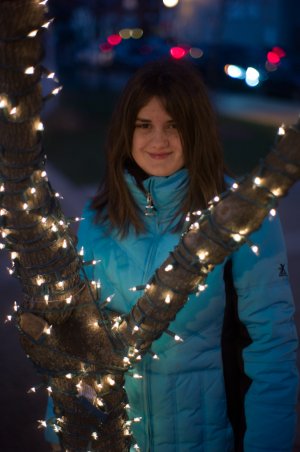
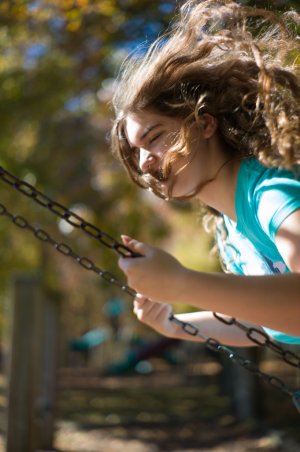
With older, uncoated lenses: when you find one that gives the look you like, never let it go. You will not find another one like it. I have a second lens made in the same batch as this one, same formula- but renders color differently. Ninety years, different life for the two lenses. Not scratched up- both are clean, but the bloom is unique.
I have the Vintage Look. Vintage lens.... Any that are older than I am.
But.... the 1934 CZJ Sonnar 5cm F1.5 is my favorite. This is the "second formulation" of the F1.5 Sonnar, this is one of the later ones of that type.
Lots of deviation from sample-to-sample after 90 years, a matter of the "Bloom" of the uncoated glass, and how they were treated. This one was like wax paper when bought for $70 off Ebay, cleaned up to "Crystal Clarity".


With older, uncoated lenses: when you find one that gives the look you like, never let it go. You will not find another one like it. I have a second lens made in the same batch as this one, same formula- but renders color differently. Ninety years, different life for the two lenses. Not scratched up- both are clean, but the bloom is unique.
x-ray
Mentor
What make these look vintage, the people, clothes, scene, contrast, grain, gradation or perhaps sharpness and acutance? I believe it’s a combination of all factors. Images are too perfect now. They’re too sharp, tonal gradation Is different and the transition tones between black and white are different especially between digital and film. Some of this, in my opinion, is due to film having physical depth where light scatters within a gelatin base with silver halide crystals. Digital is essentially a reaction that occurs on the surface with only molecular thickness.
These were images made by my father using a Russian copy of a Leica with an Elmar lens copy. The film was European, possibly Adox or Agfa, and all were shot in the early to mid 1940’s.
What makes them look vintage.
These were images made by my father using a Russian copy of a Leica with an Elmar lens copy. The film was European, possibly Adox or Agfa, and all were shot in the early to mid 1940’s.
What makes them look vintage.
Attachments
-
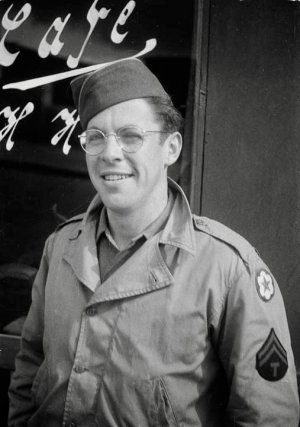 Soldier 3.jpeg85.3 KB · Views: 19
Soldier 3.jpeg85.3 KB · Views: 19 -
 Soldier 2.jpeg93.2 KB · Views: 19
Soldier 2.jpeg93.2 KB · Views: 19 -
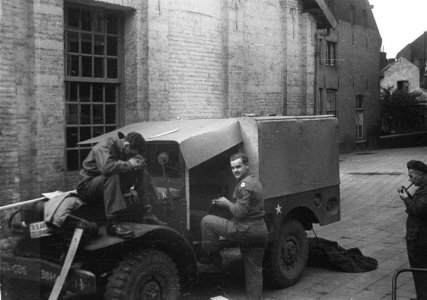 Street 9.jpeg115.6 KB · Views: 20
Street 9.jpeg115.6 KB · Views: 20 -
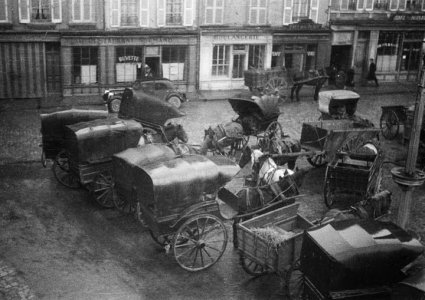 Street 6.jpeg143.3 KB · Views: 25
Street 6.jpeg143.3 KB · Views: 25 -
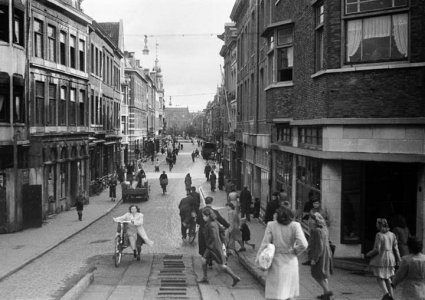 Street 7.jpeg136.6 KB · Views: 25
Street 7.jpeg136.6 KB · Views: 25 -
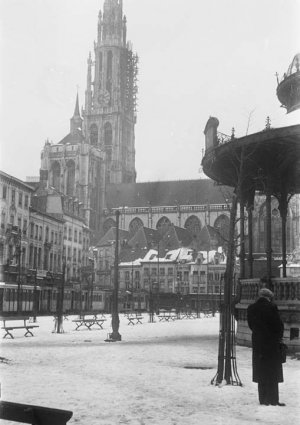 Street 4.jpeg101.8 KB · Views: 25
Street 4.jpeg101.8 KB · Views: 25 -
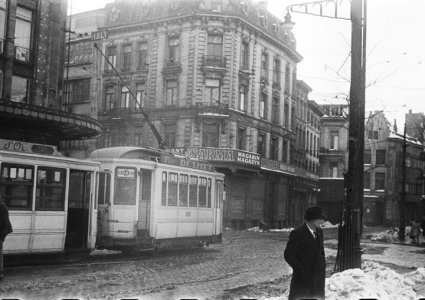 Street 3.jpeg135.6 KB · Views: 23
Street 3.jpeg135.6 KB · Views: 23 -
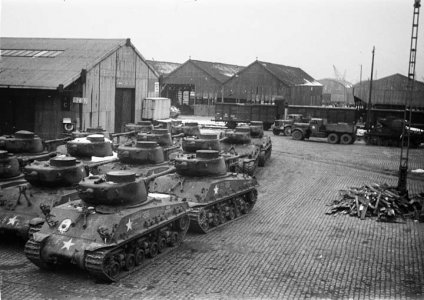 Tanks 1.jpeg128.7 KB · Views: 23
Tanks 1.jpeg128.7 KB · Views: 23 -
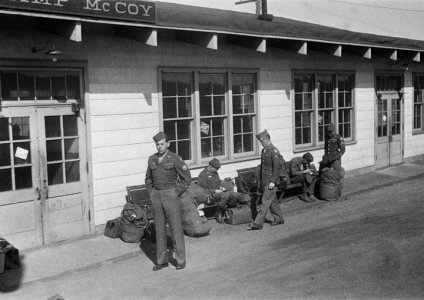 Camp McCoy 1.jpeg117.5 KB · Views: 22
Camp McCoy 1.jpeg117.5 KB · Views: 22
Share:
-
This site uses cookies to help personalise content, tailor your experience and to keep you logged in if you register.
By continuing to use this site, you are consenting to our use of cookies.


